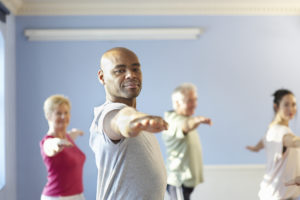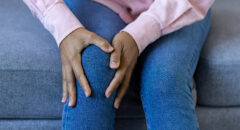
You're right on schedule for your hair appointments, you invest in your beauty, but why not invest in your overall well-being? Many of us put wellness and fitness on the backburner, but we need to take charge, especially for those of us living with rheumatoid arthritis!
Different from osteoarthritis, which is the wear-and-tear breakdown of joint cartilage experienced over time, rheumatoid arthritis, or RA, is an autoimmune disease that causes both pain and intense fatigue.
When you're in the throes of a flare, exercise may seem like mission impossible and you might be advised to rest until it passes. But exercise is an essential part of an overall treatment plan to ease RA symptoms and improve mobility. Aim for a weekly routine that includes stretching, cardio and strength training.
When Charlie Jannings, MD, talks about the value of exercise, you have to take him seriously. After all, the man is a kickboxer. He's also the reigning male athlete of the year at the Big Sky State Games, an Olympic-style event that attracts thousands of Montanans of all ages: He won four gold medals in his age group. All in all, you could say he's fairly fit for a 75-year-old.
A specialist in both geriatrics and sports medicine, Jannings has reason to be obsessed with exercise. Physical activity is a powerful remedy for chronic pain often caused by arthritis, a condition that afflicts most of the patients who come through his door. When patients seek relief for their sore, stiff joints, Jannings offers a standard prescription: "I tell them to move their joints every day in every way."
"Part of my lifestyle"
Every day in every way. Doctors all over the country are dishing out the same advice, but patients aren't always ready to listen. Jane Kowalski,* an 83-year-old living in Baltimore, had a typical response when her doctor urged her to exercise. "I was skeptical," she says. "My joints hurt, and I thought I was supposed to rest them."
Kowalski had another reason to be wary of exercise. Way back when she was 50, she decided to learn how to ride a bike. Like any novice rider, she had a few spills. But her accidents weren't child's play. In one memorable wreck, she tore ligaments in her right knee. Even when the injury healed, she knew the pain wasn't over. "My doctor said I'd get arthritis when I got old," she says. "And seven years ago, I got old."
As predicted, her right knee began to hurt. The rest of her body soon caught up. Osteoarthritis crept into her other knee, both hips, both wrists, both shoulders, and her neck. At times, the disease had such a grip on her that she couldn't get out of bed. More than once, because of the pain, she was "trapped" in the bathtub or on the toilet seat. Kowalski had two options: She could do something about her arthritis or she could lose her independence.
Kowalski has decided to fight. She starts every day with stretches to warm up her muscles and ease the stiffness in her joints. Then she works her joints with a series of exercises, including leg lifts with weights strapped to her ankles. The exercises give her the strength and flexibility she needs to get out of bed -- and get through the day. "I do them every day, come hell or high water," she says. "It's part of my lifestyle now."
Made to Move
Joints are made to move, says Jannings. If a person rests a sore knee or hip or elbow day after day, the muscles that support the joint will slowly weaken. At the same time, the tendons that attach the muscle to the bone will become less elastic. To a person with arthritis, it all adds up to more pain and stiffness.
Regular exercise can reverse this downward slide. The muscles become stronger, the tendons become more limber, and as a result pain and stiffness may start to fade. Most people begin to notice improvements within two months, although some feel better almost immediately.
For patients with osteoarthritis, there's another important benefit of exercise. Regular activity provides the lifeblood to the cartilage that cushions joints. Unlike most tissues in the body, cartilage doesn't receive nutrients from the bloodstream. Instead, it gets its nourishment from a fluid (called synovial fluid) in the joints. When a joint moves, the fluid sloshes around, giving the cartilage a healthy dose of oxygen and other vital substances. As an added bonus, regular exercise encourages the body to produce extra synovial fluid.
Strong muscles, flexible tendons, and healthy cartilage. These are the things that make everyday life possible. "Everybody needs exercise," says Barbara Resnick, Ph.D., a nurse practitioner at the University of Maryland School of Nursing. And when she says everybody, she means it. She has seen frail patients in their hundreds gain a new lease on life after taking up exercise.
The Big Four
Resnick outlines four basic types of exercise that can help patients with arthritis: Stretching, range-of-motion exercises (slowly moving the joints through their full range), strength training, and aerobics. Anyone with arthritis should incorporate each of these four types of exercise into their life, Resnick says.
She offers the following basic tips for each form of exercise:
1. Stretches. Slowly stretch to the point of mild discomfort, hold 10 to 30 seconds, and repeat three to five times. Spend at least 10 minutes a day stretching, and make sure you cover every major muscle group.
2. Range of motion. Every joint should go through its full range of motion every day. If bending the joint in a certain way causes too much pain, stick with movements that are more comfortable. Over time, try to gradually increase your flexibility until the joint regains its full range.
3. Strength training. Take it slow and easy when lifting weights. You may need to start with just a one- or two-pound weight (or even no weight at all.) Once you can do three sets of eight or 10 repetitions with ease, gradually increase the weight.
4. Aerobic activity. Enjoy a brisk walk, swim, jog, or aerobics class. Swimming and water aerobics are especially good choices if your joints are too sore for walking. No matter which activity you choose, don't push yourself too hard. At most, your heart rate should reach about 60 percent to 80 percent of its maximum.
Yoga: relief for arthritis pain
Preliminary research findings also suggest that yoga may be useful in treating some forms of arthritis, according to the Arthritis Foundation. A small, randomized, controlled study published in the Journal of Rheumatology indicated that yoga significantly improved tenderness, pain, and range of motion in the fingers among subjects with osteoarthritis of the hands. Another study in the British Journal of Rheumatology demonstrated that yoga was useful in treating rheumatoid arthritis.
An ancient discipline based on the Hindu practice of mind-body unity, yoga combines stretching, strength training, and range-of-motion exercises with mental and spiritual training; most forms include breathing and meditation techniques. As an added benefit, such techniques may help you relax and relieve some of the stresses of living with arthritis.
Because it may be difficult for older practitioners of yoga to balance, instructors advise people with arthritis to focus on yoga poses with the aid of a chair, wall, or while lying on the floor.
Getting started
Exercise isn't something to just jump into, Resnick says. Before starting any exercise program, patients should talk to a doctor, personal trainer, or physical therapist to learn which exercises are right for them. They also have to learn their own limits. As she explains, the body will sound an alarm if exercise becomes too intense. Possible signs of overexertion include chest discomfort, heavy sweating, and lingering pain or tiredness.
Some patients will have to adjust their routines day by day to keep up with their body's needs. For example, Resnick encourages patients with rheumatoid arthritis to give their sore joints plenty of rest during a flare-up. Stretches, range-of-motion exercises, and weight lifting could further inflame the joint. Wait till the flare-up is over before you resume your routine.
With any exercise program, the first steps are always the hardest. People with arthritis can have an especially difficult time getting started. When your joints creak every time you get up, a good workout is probably the furthest thing from your mind. "It's very easy to sit down and give up," says Helen Sollins, a 76-year-old arthritis sufferer living in Baltimore.
Like Kowalski and many others, Sollins decided not to take the easy way. She stretches, lifts weights, rides a stationary bike, and stays as active as possible. "Exercise gives me such a feeling of satisfaction," she says. "You feel like you've really accomplished something." Sollins has no intention of slowing down. Her daily workouts, she says, help keep her on her feet and independent. Now, there's an accomplishment.
* Jane Kowalski is a pseudonym.








